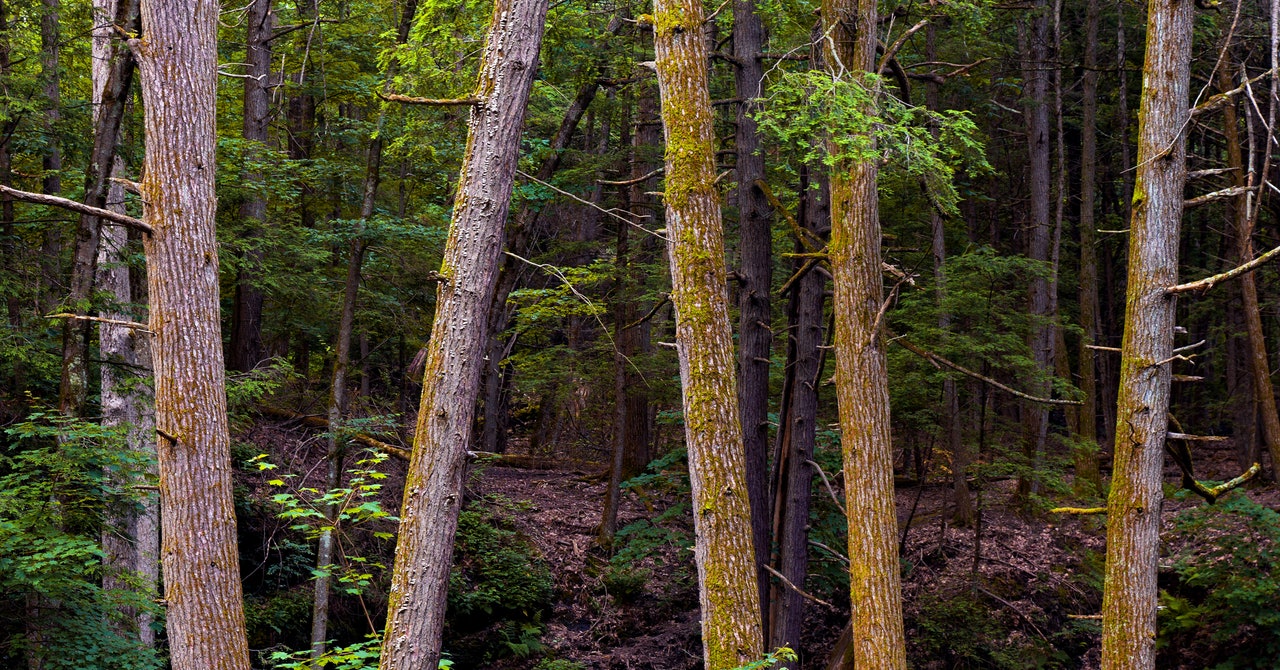
Deciduous forests are made up of many different kinds of trees that lose their leaves every winter—oak, birch, ash, maple, poplar. When an ash tree disappears from a deciduous forest—because it’s been killed off by an emerald ash borer, perhaps—other leafy trees crowd out the carnage. Hemlock forests are dominated by one type of tree. They grow in massive, undulating stands of homogenous green that are vibrant 365 days a year. When the hemlock disappears from a hemlock forest, not much is left behind.
Hemlocks are a foundation species, meaning they play a pivotal role in structuring ecological communities. Their greatest contribution is the deep shade that they create. Just 1 percent of the sunlight that hits a hemlock canopy manages to reach the forest floor. The trees’ feathered branches slope down to the ground instead of up toward the light, creating a muffled dome. Temperatures beneath this green tent can be as much as 10 degrees Fahrenheit colder than the outside world at the top of the tree and another 5 to 10 degrees colder at its base.
In the winter, the tent keeps snow off the ground. Deer gather in the circumference of the hemlock boughs, safe from the deep snow that accumulates beneath leafless deciduous trees. Ruffed grouse and barred owls nest in hemlock’s upper canopies. Snowshoe hares nibble on its green branches. Porcupines gnaw on its tannin-rich bark. In the spring, as the sun beams down and melts snow and ice elsewhere, hemlock preserve circles of snow at their trunks, which leach slowly into nearby streams and creeks and keeps them cool. Brook trout depend on these cooling infusions of icy water, as do many species of salamander, frog, toad, and fly.
Humans do, too, even if they don’t know it. Hemlocks use water more conservatively than hardwood tree species because their dense branches create moist and cool microclimates. “If you have hemlocks along streams that are replaced by hardwood that use more water, you do have the potential for drying streams, at least in the summertime,” Orwig, the Harvard Forest ecologist, said. Those streams are used for swimming, fishing, and recreation—a major part of the Northeast’s regional identity. And no matter where they grow, hemlocks provide financial and aesthetic benefits that humans enjoy. A study that looked at hemlock decline in central Connecticut and Massachusetts over the course of five years in nine counties found an accompanying decline in property values of $105 million.
“Most people just look at hemlocks as this green thing,” Whitmore, from Cornell, said. “But then you drill in further and you see all kinds of really important ecosystem functions associated with the cooling and the climate they create.”
And hemlocks aren’t just good for the critters and humans who live nearby. They’re also very good at trapping carbon dioxide.
Hemlocks can sequester approximately 12 metric tons of carbon dioxide per two and a half acres, according to a 2002 study that compared the hemlock to other tree species. That’s more CO2 than the oak trees and ponderosa pines the study analyzed. But the woolly adelgid could transform hemlocks from carbon sinks into carbon sources. That already happened in 2014 in the Harvard Forest. Researchers documented a hemlock stand that started producing carbon instead of sequestering it. “The forest can behave as a source of carbon with the loss of the hemlock,” Orwig, who helped document that shift from sink to source in a 2020 study, said.
A prior Harvard study showed that the woolly adelgid could take an 8 percent bite out of Northeastern forests’ carbon sequestering capabilities between 2000 and 2040. But that study and others predict that hardwood tree species, and an opportunistic tree called black birch in particular, will eventually replace the dead and dying hemlock—a trend researchers have already noticed in Northeast woods. Past 2040, the Harvard study projects that those black birches will capture 12 percent more carbon than the hemlocks they replaced. But in the short term, that 8 percent decrease in carbon sequestration is a big deal, says Audrey Barker Plotkin, a senior scientist at the Harvard Forest who has spent years studying the impact of invasives on hemlocks.


